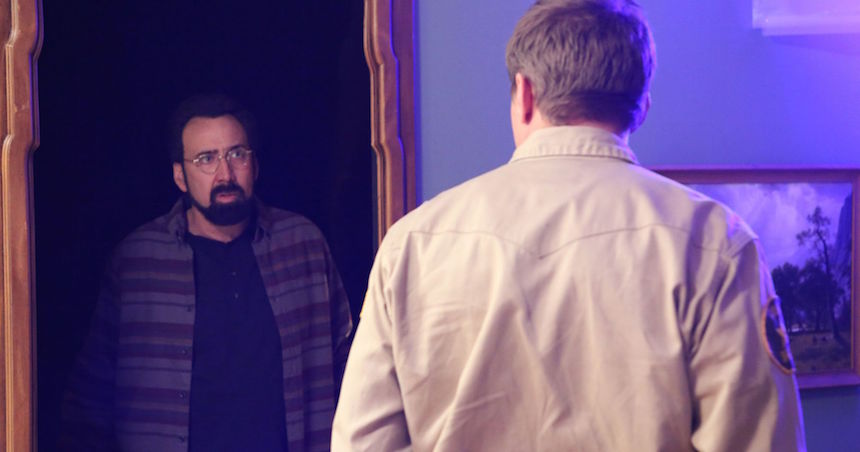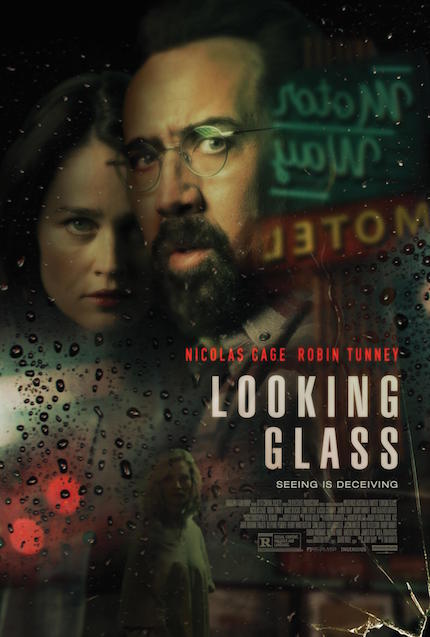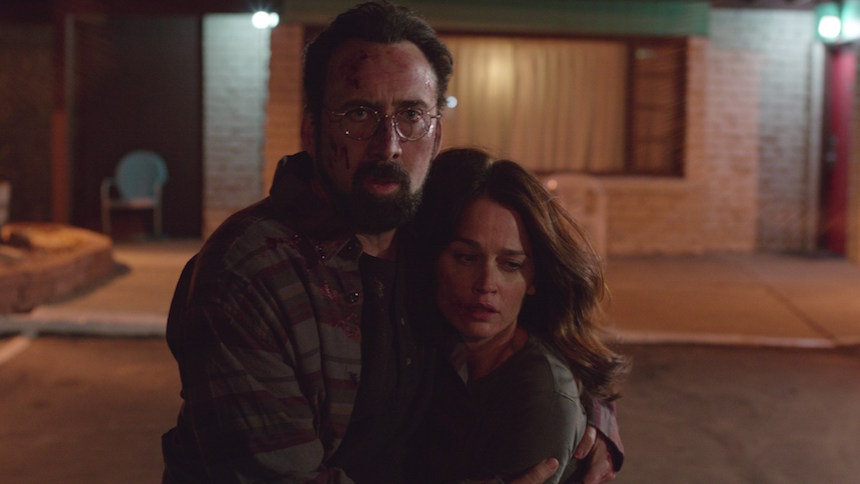Interview: LOOKING GLASS Director Tim Hunter on His Slow Burn Neon Noir

In the opening sequence of Looking Glass, we see a couple (played by Nicolas Cage and Robin Tunney) on a road trip towards their attempt to build a new life, after their daughter tragically passed away due to an accident that could have been avoided if they had been present in the moment (physically in the case of the father and mentally with respect to the mother).
To take charge of a motel, pretty much in the middle of nowhere, is the couple's plan, though once the clients begin to appear, Cage's character, in particular, gets a weird feeling about everything; something that increases when he discovers a passage that leads to the titular looking glass, which allows him to become a "Peeping Tom", watching in secret the activity that goes on inside the highly-requested room #10 of the motel.
Veteran director Tim Hunter - who has been working mainly in TV (Hannibal, Mad Men, Breaking Bad and Twin Peaks are among his credits) - took over the Jerry Rapp penned project, which is a slow burn and minimalist thriller/murder mystery, with a hint of Alfred Hitchcock and a subtle performance by Cage.
Looking Glass premieres in theaters and VOD on February 16; regarding this release, I interviewed the film's director.
ScreenAnarchy: You have been directing TV shows for quite a while and this is your first feature film in many years, so I'm wondering what got you interested once you read the script of LOOKING GLASS?
Tim Hunter: I liked a lot of things about it. I hadn't done a feature for a while, like you were saying, and I was certainly happy to get back into the longer form of real movies. I liked it because it was in the film noir/neon noir/murder mystery genre, which is very close to my heart, but at the same time it was more than that, it had really interesting thematic and psychological issues.
Now that you mention the neon noir, your color palette is sometimes reddish, other times blue and green. What can you tell me about the style you were interested in exploring?
Patrick Cady, the cameraman, and I wanted it to be expressionistic and push the color as much as we could. Both of us have been working in television, and in TV they tend to hold you back to a fairly realistic palette, so we saw this as an opportunity to stretch stylistically.

Obviously a film like this one references Alfred Hitchcock and a number of other noir directors, but we were also looking at modern still photography.
We looked at a lot of photographs by a guy named Todd Hido, who takes this great landscapes, sides of buildings, vacant lots, and somehow manages to wash them all in orange or green, transforming the ordinary into something that looks more surreal. That's what we were going for.
We found this motel, which was a wonderful location for a number of reasons, mostly because the rooms weren't flat, they had angular partitions between them, so the whole thing was very camera friendly. We got color and party lights, anything that we could actually use as lighting and buy at the local store.
There's a Hitchcock feeling, like you said, with the voyeuristic element. Why do you think this notion of following an observer is still so fascinating?
That's a very good question. Hitchcock proved, almost a century ago, that movies lend themselves, when they're not busy doing a big objective panorama of action, to point of view, they lend themselves to getting inside the mind of a character through point of view and montage; going back and forth between the character and their POV. I don't think that's ever going to get stale in movies, it's just an organic part of movie storytelling, if you're trying to convey the inner life of somebody visually.
This is a low-budget project and basically you have one main location, which is the motel. What was the greatest challenge to keep it interesting and mysterious?
The greatest challenge in a picture like this is often just putting the locations together so that they form their own screen geography even if that's different from the real life geography of the location. In the script, for example, the hole that leads Nic's character to the mirror behind the room was written as something that has been built behind the motel, added on like a mine shaft and built outside the back wall. I was thinking, how on earth are we going to find the motel where we can put up a tunnel structure behind?
But this motel had actual basements that we used, which had a tunnel that worked below the rooms and had all kinds of openings that suggested that there were tunnels underneath. The location created its own reality for us and we adapted the script to the location. The tunnel itself was a set that we built on a stage, as well as the room channel, but everything else was on location at the actual motel.
We know Nicolas Cage can do all kinds of roles and this time we have a more subtle performance by him. How was the creative process with Nic for this character?
When I took the job, he was already the star and he had approved the script. He does a lot of pictures in a given year, so a director who hasn't worked with him before might worry at the beginning that perhaps he just goes from picture to picture and doesn't care that much. But in fact he was deeply committed to this script, from the moment he showed up, he knew it backwards, he knew the character and all the subtlety and nuance that he wanted to put in it. The creative process with him was really excellent for me and everybody else, because he was so professional and so prepared.
As a director, I'm kind of a quiet guy, so I really liked that it was quieter than some of his much bigger performances in pictures where he has to go crazy or get revenge or just play it in a much bigger range. It's still a Nicolas Cage performance, it's periodically stylized and eccentric, pushing the boundaries of reality a little bit, but in a more nuance way. I was delighted and got better and better in the editing room after the heat of shooting a picture in 20 days.

The movie presents you the background of the couple, which is quite tragic and human. I think sometimes genre films forget that, so how important was for you to make sure the audience did care for them?
Very important. The picture perhaps takes a little while longer to get going than some pictures, but I like that kind of picture that gives you time to get to know the people, because then when the plot really clicsk in, the audience knows the people better and they have a bigger stake in what's going on. I like pictures that kind of sneak into the backdoor a little bit, because sometimes those are the ones that can really grab you when you don't expect it.
For me, it was a neon noir about a conflicted man and a conflicted couple. He wants to be faithful to his wife and he wants to stay in their marriage, even though he possibly cheated on her and she was drinking too much and taking pills when their daughter fell off the balcony. So they're in a very precarious place at the beginning of the picture, trying to stay together and start a new life. But there's clearly an unresolved, psychological dark side inside him; the sex murder mystery is placed to that. That drew me to it because although the plot is resolved, the underlying psychological issues are still there at the end of the picture.







